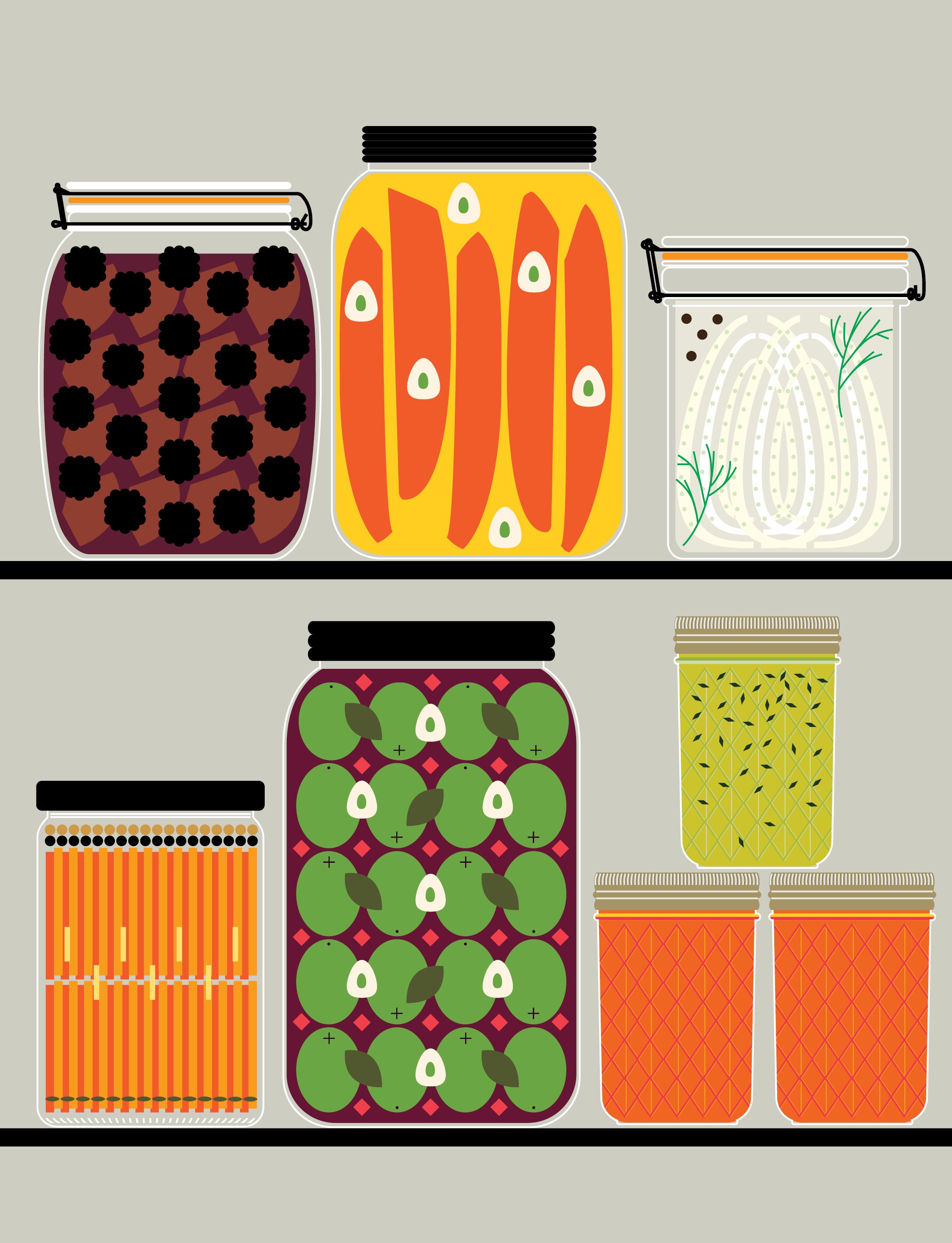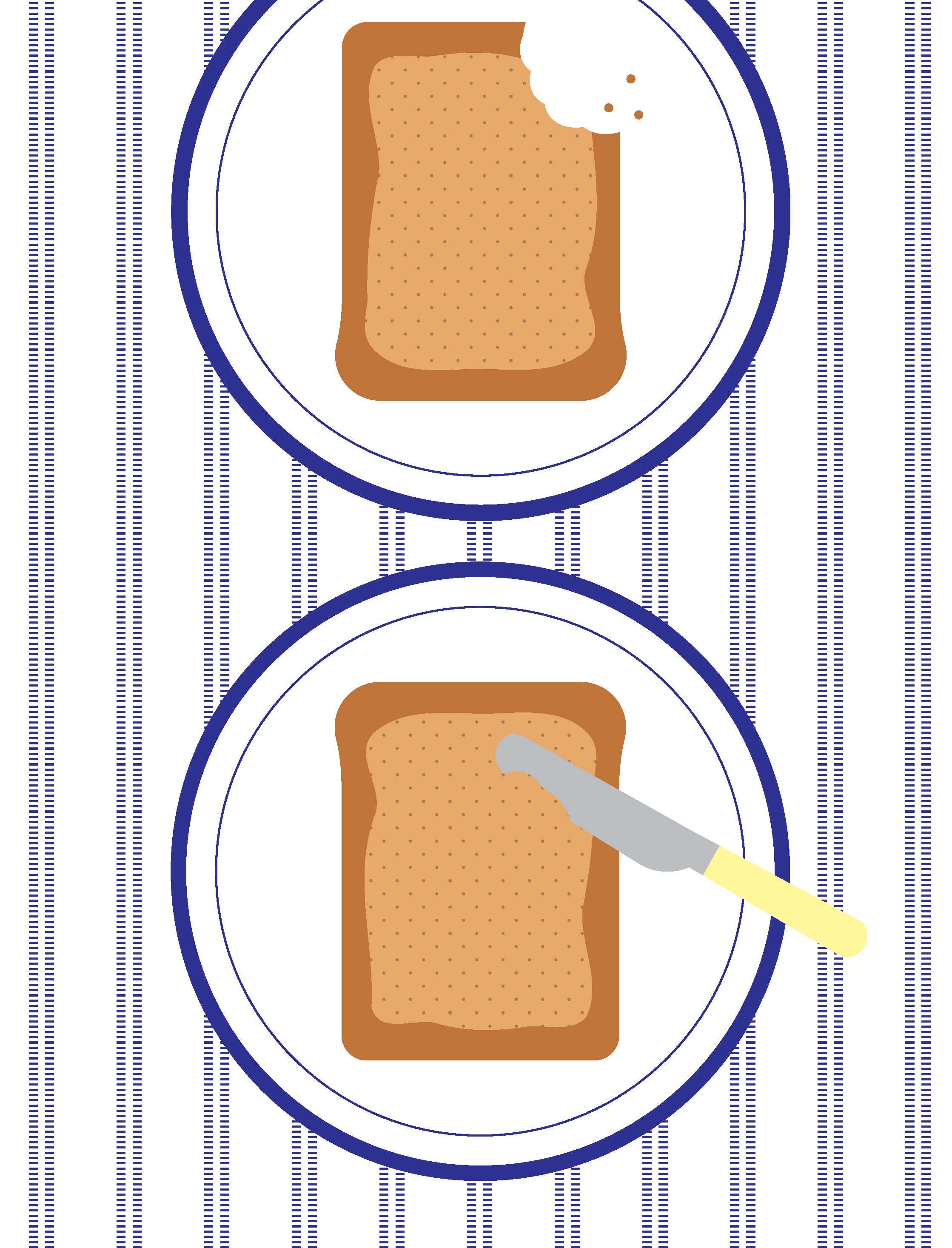The Preserving Garden by Jo Turner
With beautiful illustrations adorning its pages, Jo Turner’s new cookbook The Preserving Garden, shows us how to bottle, pickle, ferment and cook homegrown food – all year round.
Words: Jo Turner I Illustrations: Ashlea O’Neill
Preserved vegetables from The Preserving Garden. Illustration: Ashlea O’Neill
Almond butter from The Preserving Garden. Illustration: Ashlea O’Neill
Types of preserves
Bottled Fruit
There are times when you have an abundance of fruit and little inclination or inspiration to turn it into something else. When these occasions arise, the fastest and most satisfying response is to ‘bottle’ whole, halved or sliced fruit in water or syrup. If you are in Australia and own a Fowlers preserving kit, this can be done by packing jars and processing for 1 hour, no matter the size of the jar or quantity or variety of fruit. If you don’t have a preserving kit, using the water bath method is an efficient and accessible process.
Chutney and Relish
Chutney and relish both mix fruit or vegetables with spices and herbs. Relish usually contains vegetables and has a pronounced vinegary flavour, while chutney is thicker and sweeter and typically contains fruit cooked until very soft: I think of it as a rich, savoury jam.
Jam, Jelly and Marmalade
To make jam, fruit and sugar are cooked together until the fruit breaks down and pectin is released to dissolve in the juices. The method for marmalade is similar, with some recipes calling for the additional step of soaking finely sliced peel before cooking. For jelly, the cooked fruit mixture is strained through muslin, and the resulting liquid is cooked with sugar (around 450 g/1 lb to every 600 ml/11/4 pints of liquid) until a set is achieved. Too much sugar will make a soft, syrupy jelly; too little and the result will be rubbery.
Use plain white sugar for fruit jams and jellies as it does not alter the colour or flavour of the fruit. Feel free to experiment with different types of sugar but avoid artificial sweeteners; they do not provide the setting power of sugar and can impart a bitter flavour when cooked.
To test if jam, jelly or marmalade has reached setting point, place a small saucer in the freezer as you put the fruit on to cook. When you think it’s nearly ready, turn off the heat and place a teaspoon of the preserve mixture on the chilled saucer. Return to the freezer, and after a few minutes gently push it with your finger; the surface should pucker or wrinkle. Don’t fret if your first test is unsuccessful – simply return the saucer to the freezer and the pan to the heat for another 5 minutes, then test again.
Pickling and Fermenting
Both pickling and fermenting create a delicious sour flavour; the difference between the two is how that is achieved. Pickled foods rely on an acidic brine containing salt and vinegar, while fermented foods utilise naturally occurring sugars and bacteria to create a chemical reaction.
The acidity level is crucial to the safety, flavour and texture of pickled vegetables, and changing the ratio of vinegar, water and vegetables can affect all of these qualities. The vinegar must have an acid content of at least 5 per cent, so check the label before use; apple cider vinegar and rice vinegar, for example, do not always have the required level of acidity.
Use un-iodised salt as it produces a clear pickling liquid. The same goes for white sugar; brown sugar may be used but it will affect the colour and clarity.
For the flavourings, use whole spices and washed fresh herbs as they give the best flavour and appearance. Dried herbs and ground spices will make the brine cloudy.
Select firm young vegetables free of blemishes and use within 24 hours of picking (purchased fruit and vegetables should be sourced from a reliable supplier and used as soon as humanly possible – certainly no later than 24 hours after purchase). Wash and drain all produce before use.
Metal lids are not suitable for sealing jars with vinegary contents. Look for lids that have a non- metallic barrier or film on the underside.
Many brined vegetables can be stored in the fridge for 2–3 weeks. Processing in a water bath extends the shelf-life considerably.
A Note on Pectin
Pectin is a naturally occurring fibre that, when combined with sugar and acid, forms a bond that causes jam to set. All fruits have different levels of pectin; strawberries are notoriously low in this setting agent, while crab apples have very high levels and are often cooked with other fruits for this reason.
I’ve included a note about the pectin levels found in each variety of fruit. They are at their highest when fruit is unripe, so choose just-ripe or slightly under-ripe fruit to make jam and jelly. The peel, pips, juice and pith of citrus fruit can improve the setting qualities of fruits with moderate pectin levels. Tie the peel, pips and pith in a small muslin bag and add to the preserving pan. Liquid and powdered pectin are colourless, flavourless extracts made from high-pectin fruits and can be used to set jam and jelly made with low-pectin fruit.
Preserved passionfruit pulp from The Preserving Garden. Illustration: Ashlea O’Neill
Preserved peaches from The Preserving Garden. Illustration: Ashlea O’Neill
“With all my senses, I can recall sitting at the table in my nan’s kitchen with my mum and aunt as they worked to transform a wooden crate of yellow peaches into jars of bottled fruit – sunny orbs ready to enjoy over the coming twelve months.”
STRAWBERRY & RHUBARB JAM
Strawberries and rhubarb are a match made in heaven - the combination of sweet and tart flavours produce a jam that is so much more than the sum of its parts.
Makes about 5 cups
INGREDIENTS
750 g (1 lb 11 oz) strawberries, washed and hulled, or frozen strawberries (no need to thaw)
500 g (1 lb 2 oz) rhubarb, washed and cut into 2.5 cm (1 inch) pieces
60 ml (¼ cup) freshly squeezed lemon juice
2 tablespoons powdered pectin
350 g (12½ oz) sugar
5-6 × 250 ml (8½ fl oz) sterilised jars
METHOD
Place a small saucer in the freezer. Combine the fruit, lemon juice and pectin in a heavy-based saucepan.
Cover and cook over low heat, stirring occasionally, for 15 minutes or until the fruit has softened to a pulp.
Add the sugar and stir until it has dissolved, then increase the heat and boil, stirring occasionally, for 10-15 minutes.
To test for set, remove the pan from the heat and place a spoonful of iam on the cold saucer. Pop the saucer back in the freezer for a couple of minutes - if the jam wrinkles when pushed, it is ready. If not, cook for another 5 minutes, stirring as it comes back to the boil so the fruit doesn't stick to the bottom of the pan, and test again.
When the jam is at setting point, turn off the heat and allow it to sit for 10 minutes. Skim off any foam, then pour the jam into five or six warm sterilised 250 ml (8½ fl oz) jars (see page 15), leaving 1 cm (½ inch) headspace if processing in a water bath.
Wipe the rims. If you choose not to process the jam in a water bath allow the jam to cool completely before sealing the jars.
Otherwise, seal the jars immediately and process in a water bath for 15 minutes. Refrigerate after opening.
This is an edited extract from The Preserving Garden by Jo Turner, published by Thames & Hudson Australia, RRP $49.99. Available where all good books are sold and online.











